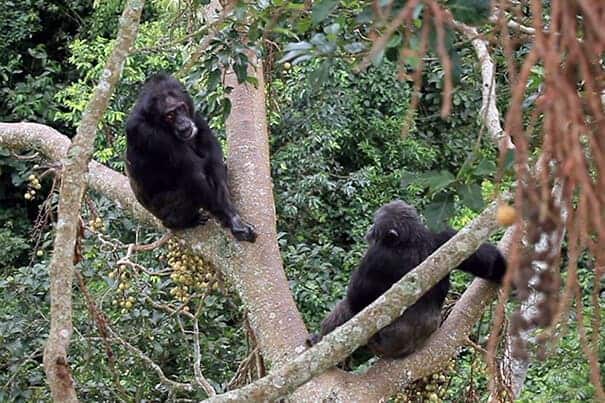Think of all the things your mom taught you — sit up straight, close your mouth when you chew, remember to say please and thank you … the list goes on.
When it comes to learning how to behave, though, humans aren’t alone in looking to their mothers.
A group of researchers led by Richard Wrangham, the Ruth B. Moore Professor of Biological Anthropology, has shown, for the first time, that chimpanzees learn certain grooming styles from their mothers — and once learned, they continue to perform the behaviors the same way, long after the deaths of their mothers. The study is described in a paper in Current Biology.
“I think what it really shows is how strong the maternal influence is,” Wrangham said. “It’s very charming, really — our oldest-known son was almost 40 years old, still doing what his long-dead mother did.”
The scientists studied “high-arm grooming,” a behavior that occurs during the regular grooming sessions chimps engage in throughout the day. As two chimps groom each other, each raises one arm and either clasp hands or cross their arms as they continue to groom. Though brief — sessions average only about 45 seconds — chimps have been observed in this behavior as many as 10 times a day.
But while grooming behavior is universal among chimps, high-arm grooming is not. It has been observed in eight chimp populations across Africa, Wrangham said, each of which display differing rates of clasping and non-clasping, but is notably absent in three other well-studied populations.
It’s not clear whether any significance should be attached to those differences. At present, researchers have no clear answer as to why chimps engage in high-arm grooming, or what benefits they get from it.
“What we wanted to understand was what’s responsible for the variation in palm-to-palm clasping,” Wrangham said. The researchers wondered, “When a young female joins a new group, does she look at what everyone else is doing … and then do what the rest of the group does for the rest of her life?”
To find out, Wrangham and colleagues collected the most detailed data ever on how — and how often — chimps in a particular population engaged in high-arm grooming. They quickly realized that nearly all previous theories about the behavior were wrong.
“This type of behavior, which seems so trivial in many ways — whether you clasp hands or cross arms — has been suggested as signaling membership in a group,” Wrangham said. “People often see these types of strange behaviors we see in chimps and wonder if it is some sort of group identification sign.
“Alternatively, people have suggested that maybe it signals a special type of social relationship if two individuals do it more often with one another. But what we’re showing with this paper is that none of the obvious possibilities figure out,” he continued. “The pattern varies widely within the group, it’s not closely associated with friendship, it doesn’t vary by age or sex, and it does not depend on how long an individual has been in the community.”
In fact, he said, the only connection researchers were able to identify was the maternal one. The chimpanzees are copying their mothers, not identifying with the larger community.
Like human children, young chimps learn many behaviors from their mothers, from which foods to eat to how to use tools to — among the mothers who engage in it — how to perform high-arm grooming. And because young chimps may groom almost exclusively with their mothers until about age 12, Wrangham said it’s little wonder that the style they learn stays with them into adulthood.
“Even when they’re adults, even after their mothers are long dead, they still do it the same way their mother did it,” Wrangham said. “This is the first time anyone has realized this, and the pattern is delightfully clear.”
While it’s tempting to assign some larger significance to the behavior, Wrangham said studies thus far haven’t been able to show whether high-arm grooming carries any social meaning.
“People may say it’s important because they stick to it,” he said. “But the alternative view is that no one in the group cares. There’s never rejection [when a clasper meets a non-clasper] — everyone has tended to think that this is something that would be seen more among individuals that have a strong alliance relationship, but it turns out to not be true.”
That finding, Wrangham said, leaves several questions still to be answered, and the hope is that further study may yet yield some insights into the behavior.
“Now that we know some families clasp hands as much as 90 percent of the time, and others do it only 10 percent, what happens when you get two individuals high-arm grooming together when one is a clasper and the other is not?” Wrangham said. “What is it that decides which pattern they will use? Is it dominance? Is it the higher-ranking individual? The older one? Or maybe it is the one that initiates?
“Our current evidence suggests that neither dominance nor age carries sway. Eventually, I hope we can work out the social significance of this quirky behavior. If we can find a pattern for which individual ‘wins’ when a clasper grooms with a non-clasper, maybe we will get a clue to why individuals do high-arm grooming at all.”


